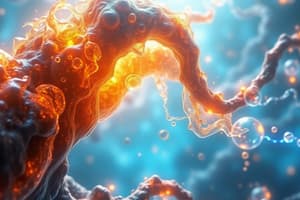Podcast
Questions and Answers
What happens to a glucose molecule during glycolysis?
What happens to a glucose molecule during glycolysis?
- It is converted into ethanol and CO2.
- It is broken down into two molecules of pyruvate. (correct)
- It is oxidized to acetyl CoA.
- It directly produces ATP without any other reactions.
Which of the following best describes oxidative phosphorylation?
Which of the following best describes oxidative phosphorylation?
- It is the phase where ATP is synthesized through chemiosmosis. (correct)
- It does not produce ATP but only electron carriers.
- It occurs during glycolysis only.
- It involves the direct transfer of a phosphate group from a substrate to ADP.
Which two electron carriers transfer electrons derived from glucose to the electron transport chain?
Which two electron carriers transfer electrons derived from glucose to the electron transport chain?
- FADH2 and NAD+
- NADH and ATP
- FAD and NADP+
- NADH and FADH2 (correct)
How is some ATP synthesized during cellular respiration?
How is some ATP synthesized during cellular respiration?
In the reaction CH2O + FAD → CHO2 + FADH2, which compound is reduced?
In the reaction CH2O + FAD → CHO2 + FADH2, which compound is reduced?
What happens to glucose during cellular respiration?
What happens to glucose during cellular respiration?
Which statement describes the role of O2 in cellular respiration?
Which statement describes the role of O2 in cellular respiration?
What is the primary energy source produced during cellular respiration?
What is the primary energy source produced during cellular respiration?
Which type of molecules are considered good fuels for oxidation?
Which type of molecules are considered good fuels for oxidation?
What characterizes the electron transfer in respiration?
What characterizes the electron transfer in respiration?
What process does the combustion of methane exemplify?
What process does the combustion of methane exemplify?
Which of the following is true regarding the transformation of energy during respiration?
Which of the following is true regarding the transformation of energy during respiration?
What is released as a byproduct of glucose oxidation in cellular respiration?
What is released as a byproduct of glucose oxidation in cellular respiration?
What is the primary role of the electron transport chain in cellular respiration?
What is the primary role of the electron transport chain in cellular respiration?
Which of the following correctly describes a consequence of uncontrolled electron transfer from hydrogen to oxygen?
Which of the following correctly describes a consequence of uncontrolled electron transfer from hydrogen to oxygen?
What happens to electrons as they move down the chain of the electron transport system?
What happens to electrons as they move down the chain of the electron transport system?
Which metabolic stage of cellular respiration involves the breakdown of glucose into pyruvate?
Which metabolic stage of cellular respiration involves the breakdown of glucose into pyruvate?
What is the final electron acceptor in the electron transport chain?
What is the final electron acceptor in the electron transport chain?
Which of the following statements about glycolysis is true?
Which of the following statements about glycolysis is true?
How does ATP synthesis occur in the process of chemiosmosis?
How does ATP synthesis occur in the process of chemiosmosis?
What occurs during pyruvate oxidation?
What occurs during pyruvate oxidation?
Which of the following best describes the catabolic pathways involved in cellular respiration?
Which of the following best describes the catabolic pathways involved in cellular respiration?
Which of the following is a product of the electron transport chain?
Which of the following is a product of the electron transport chain?
What is the primary function of fermentation in cellular metabolism?
What is the primary function of fermentation in cellular metabolism?
Which process is specifically used to produce ethanol?
Which process is specifically used to produce ethanol?
During lactic acid fermentation, what is directly produced from pyruvate?
During lactic acid fermentation, what is directly produced from pyruvate?
What is a byproduct of alcohol fermentation?
What is a byproduct of alcohol fermentation?
Which of the following organisms is known to perform alcohol fermentation?
Which of the following organisms is known to perform alcohol fermentation?
What is the main role of NAD in the process of fermentation?
What is the main role of NAD in the process of fermentation?
Which type of fermentation does not produce carbon dioxide as a byproduct?
Which type of fermentation does not produce carbon dioxide as a byproduct?
Which of the following best describes where alcohol fermentation occurs?
Which of the following best describes where alcohol fermentation occurs?
What happens to glucose during cellular respiration?
What happens to glucose during cellular respiration?
What is the primary final electron acceptor in fermentation?
What is the primary final electron acceptor in fermentation?
Which coenzyme acts as an electron carrier during cellular respiration?
Which coenzyme acts as an electron carrier during cellular respiration?
What is the primary function of NAD+ in cellular respiration?
What is the primary function of NAD+ in cellular respiration?
How much ATP is produced by fermentation per glucose molecule?
How much ATP is produced by fermentation per glucose molecule?
Which process requires an electron transport chain to regenerate NAD+?
Which process requires an electron transport chain to regenerate NAD+?
What remains after dehydrogenases remove hydrogen atoms from glucose?
What remains after dehydrogenases remove hydrogen atoms from glucose?
What characterizes an obligate anaerobe?
What characterizes an obligate anaerobe?
How do electrons lose potential energy during cellular respiration?
How do electrons lose potential energy during cellular respiration?
What byproduct is formed when hydrogen reacts with oxygen in cellular respiration?
What byproduct is formed when hydrogen reacts with oxygen in cellular respiration?
Which of the following is a product of lactic acid fermentation?
Which of the following is a product of lactic acid fermentation?
What is a characteristic of NAD+ as an electron acceptor?
What is a characteristic of NAD+ as an electron acceptor?
What happens to pyruvate under aerobic conditions in yeast cells?
What happens to pyruvate under aerobic conditions in yeast cells?
What is the maximum ATP yield from one molecule of glucose during aerobic respiration?
What is the maximum ATP yield from one molecule of glucose during aerobic respiration?
Why is the explosive reaction between hydrogen and oxygen not efficient for energy production in cells?
Why is the explosive reaction between hydrogen and oxygen not efficient for energy production in cells?
In the reaction catalyzed by dehydrogenases, what is formed alongside NADH?
In the reaction catalyzed by dehydrogenases, what is formed alongside NADH?
Which type of muscle fibers primarily uses aerobic respiration?
Which type of muscle fibers primarily uses aerobic respiration?
What is the significance of NADH formed during respiration?
What is the significance of NADH formed during respiration?
Which organism type can survive by using either fermentation or respiration?
Which organism type can survive by using either fermentation or respiration?
What occurs during glycolysis in all three pathways?
What occurs during glycolysis in all three pathways?
Flashcards are hidden until you start studying
Study Notes
Redox Reactions
- Oxidation involves the loss of electrons or hydrogen, while reduction involves the gain of electrons or hydrogen.
- In cellular respiration: glucose (C6H12O6) is oxidized to carbon dioxide (CO2), and oxygen (O2) is reduced to water (H2O).
- The equation for respiration: C6H12O6 + 6O2 → 6CO2 + 6H2O + Energy represents a redox process.
Cellular Respiration Overview
- Cellular respiration can be divided into three stages:
- Glycolysis: occurs in the cytosol, breaking glucose into two pyruvate molecules.
- Pyruvate Oxidation and Citric Acid Cycle: further oxidation of pyruvate occurs in mitochondria, resulting in CO2 production.
- Oxidative Phosphorylation: involves electron transport chains and chemiosmosis, generating ATP.
NAD+ and Electron Transport Chain
- Nicotinamide adenine dinucleotide (NAD+) serves as a key electron carrier, cycling between oxidized (NAD+) and reduced forms (NADH).
- Dehydrogenase enzymes remove hydrogen atoms from glucose, oxidizing it and transferring electrons to NAD+, forming NADH.
- NADH stores energy that can be transferred to generate ATP as electrons are passed down the electron transport chain.
Energy Release Mechanism
- The electron transport chain consists of proteins embedded in the mitochondrial inner membrane.
- Electrons move down the chain, releasing energy used to pump protons, creating a proton gradient utilized for ATP synthesis.
- This process contrasts with single-step reactions (e.g., hydrogen and oxygen explosion), enabling controlled energy release.
Fermentation Processes
- Fermentation regenerates NAD+ by transferring electrons from NADH to pyruvate or its derivatives, allowing glycolysis to continue.
- Alcohol fermentation converts pyruvate to ethanol and CO2; lactic acid fermentation converts pyruvate directly to lactate, regenerating NAD+ without CO2 release.
Comparison of ATP Production
- Fermentation: yields 2 ATP per glucose molecule via substrate-level phosphorylation.
- Aerobic respiration yields up to 32 ATP per glucose due to electron transport chain efficiency, maximizing energy extraction.
- Anaerobic respiration uses another electron acceptor instead of oxygen, resulting in lower energy yield than aerobic respiration.
Muscle Fiber Types and Lactic Acid
- Human muscles have two fiber types: red muscle (aerobic, oxidizes glucose completely) and white muscle (produces lactate even in the presence of oxygen).
- Lactate produced by white muscle can be oxidized by nearby red muscle or transported to the liver for glucose formation.
- Not all lactate production is due to anaerobic conditions; it can occur even during aerobic respiration in muscle cells under certain circumstances.
Studying That Suits You
Use AI to generate personalized quizzes and flashcards to suit your learning preferences.




